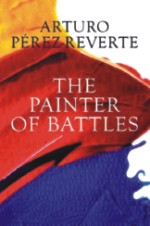|
Book Review
The Painter of Battles
Alan Cheuse
 Just as we have our one-of-a-kind popular writers these days in John Grisham and Stephen King, Spain claims Arturo Pérez-Reverte, one of contemporary fiction's great entertainers. Most of his novels take us back into European history, but now and then he has touched on the contemporary world. In "The Painter of Battles," his latest novel to be translated here, he introduces us to a contemporary with a vengeance: Andres Faulques, a renowned war photographer, who, under the weight of grief and conscience, has withdrawn to an old tower overlooking a bay on Spain's southeast coast, where he has given up photography for painting, an art form he finds difficult and laborious. Just as we have our one-of-a-kind popular writers these days in John Grisham and Stephen King, Spain claims Arturo Pérez-Reverte, one of contemporary fiction's great entertainers. Most of his novels take us back into European history, but now and then he has touched on the contemporary world. In "The Painter of Battles," his latest novel to be translated here, he introduces us to a contemporary with a vengeance: Andres Faulques, a renowned war photographer, who, under the weight of grief and conscience, has withdrawn to an old tower overlooking a bay on Spain's southeast coast, where he has given up photography for painting, an art form he finds difficult and laborious.
"He had a good hand for drawing," we learn in the opening chapter, "but he was a mediocre painter." Faulques, or "the painter of battles" as he is often referred to in these pages, is pushing ahead with his new life-project, a mural on the subject of war that will cover all of the cracking inside walls of the tower. His monumental project incorporates images from major battle paintings by various Western artists as well as some from his two decades as a battlefield photographer in Africa, the Middle East, the Balkans and elsewhere (accompanied in recent years by his last lover, a daunting though not greatly talented Italian woman named Olvido Ferrara). "There was no ambition to achieve a masterwork," we hear. "[T]he mural did not even pretend to be original, although in reality it was the sum and combination of countless images taken from painting and photography that would be impossible without the existence and the eye of the man who was painting in the tower."
The second chapter immediately changes the pitch of the narrative. It opens with the appearance of a visitor to the tower, a stranger who over the course of the rest of the novel becomes quite familiar to the painter of battles. His name is Ivo Markovic, a former foot soldier, who announces to Faulques that he wants revenge for being featured in one of the man's photographs from a battlefield in the Balkans.
The photograph "destroyed my life," and brought down horror on him and his family, Markovic explains. "Now I know enough to agree that it wasn't entirely the work of chance, since there are circumstances that brought you and me to that exact moment on that exact day. And as a consequence of the process begun by you, by me, by whoever, I'm here now. To kill you."
The rest of the novel takes us back and forth between the painter's daily round and his recollections of his past work as a photographer, with his memories of the now deceased Olvido growing more powerful by the hour as his final confrontation with Markovic draws inevitably closer. Were it not for his recollective state of mind, Faulques' encounters with Markovic would have made for a taut if melodramatic narrative - one about half the size of the present volume. But those forays into the past, added to the pages given over to the description of the painter's unfolding mural, lift the story out of the realm of melodrama and give it a heft and gravity it probably could not have otherwise obtained.
"The painter of battles stirred, running his fingers along the cold, rough edges of the crack in the wall. Raw meat, he remembered suddenly, beside amphibian tracks in the sand. Horror always lying in wait, demanding tithes and first fruits, poised to decapitate Euclid with the scythe of chaos. Butterflies fluttering through all wars and all peaces. Every moment was a blend of possible and impossible situations, of cracks predicted from that first instant at a temperature of three billion kelvins within the fourteen seconds and the three minutes following the Big Bang, the beginning of a series of precise coincidences that create man, and that kill him. Drunken gods playing chess, Olympian risk-taking, an errant meteorite only ten kilometers in diameter that, when it struck the Earth and annihilated all animals weighing more than twenty-five kilos, cleared the way for the then small and timid mammals that sixty-five million years later would become Homo sapiens, Homo ludens, Homo occisor."
Laying on page after page of this philosophical rhetoric, the way his artist hero slathers parts of his mural in paint, tends to amplify Faulques' fate, as Pérez-Reverte elevates his novel above the level of the merely entertaining pages of King and Grisham. It also, alas, reminds American readers of the sublime rhetoric of Faulkner and how such passages in the hands of a master can add to the momentum of the story and how, in instances such as this, it can also drown out the music of the plot.
This review first appeared in The San Francisco Chronicle.
Copyright
(R) thedailystar.net 2007
|
